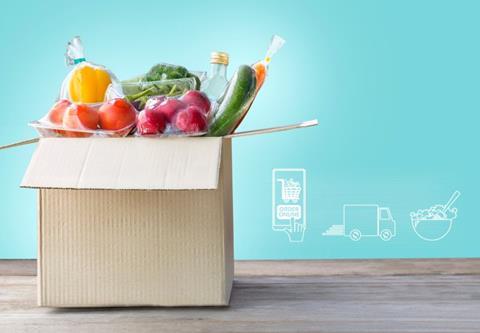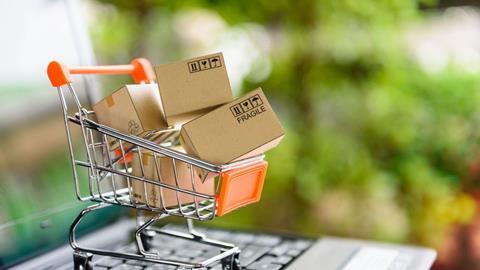E-commerce sales have seen impressive growth in recent years, and the trajectory is set to increase even further. With consumer demands growing in line with pack developments, what are the challenges? And what steps are packaging companies taking to stay ahead of the game? Elisabeth Skoda reports.
Packaging for e-commerce needs to withstand a lot of pressure. In its recently launched Rethinking Packaging report, courier giant DHL observes that while brick-and-mortar retailers typically require packaging to be drop tested from five different angles, leading online retailers may ask for 18 separate drop tests. Future e-commerce innovations are likely to further intensify demands on packaging. According to the report, logistics providers are now on their fourth or fifth generation of drone delivery projects and are exploring delivery with unmanned ground vehicles. Combined with growing demand for unattended delivery formats, packaging will need to evolve to allow items to be left outside the customer’s home, exposed to inclement weather and the risk of theft.

A driver for growth
According to statistics from eMarketer, worldwide retail e-commerce sales are set to grow to over 20% of total sales by 2023. China and the USA are leading the way in the area of e-commerce, but Western Europe, especially the UK, Germany and France are also developing strongly. Yi Jiang, Amcor’s e-commerce and business development director, says that the company is investing in e-commerce packaging to support customers’ growth agenda.
“Our customers recognise that they have to be where the consumers are – and today’s consumers are online a lot. Beyond growth directly from online sales, according to Forrester Research, half of all retail sales in the US are digitally influenced. Therefore, what you do as a brand online is going to influence your offline sales. With that being said, maturity of e-commerce development can vary greatly from company to company, from category to category. So there is still a lot to learn for brands working with supply chain partners to improve consumer experience in e-commerce.”
She explains that supply chain complexity poses a big challenge.
“In traditional brick and mortar channels, there are around five points of handling, but there are at least ten in the e-commerce supply chain. Another challenge is demand uncertainty. Consumer feedback comes in quickly. If a customer doesn’t like the product or the packaging, they will share their opinion, so you have to react fast.
“Lastly, sustainability and how it is viewed by consumers is a big challenge. Many online consumers are sustainability conscious and are more likely to complain about a pack that’s perceived as not sustainable on Amazon than at their local supermarket. Feedback about product and packaging are amplified. Therefore, a lot of exploration work is needed to optimise a pack for different channels, be it brick and mortar stores, e-commerce or omnichannel. Packaging companies can support their customers in both the exploration phase and packaging development phase.”
While product protection in transit is highly relevant this needs to be balanced with ease of use for the customer. In the brick-and-mortar retail environment, packaging is often designed to thwart theft or tampering, for example by using rigid clamshells with sealed edges.
Freed from the need to protect products from shoplifting, e-commerce retailers have encouraged the development of packaging designs that prioritize access with minimal effort, as it is observed in DHL’s Rethinking Packaging report. Consumers are equally intolerant of quality problems. The report states that almost 50% of e-commerce customers said that receiving a damaged item would make them less likely to purchase from the same retailer again.
E-commerce only or omnichannel?
Amcor’s experts devised a checklist to ascertain whether omnichannel packaging or channel-specific packaging is the best choice. They recommend an omnichannel approach if: a brand already sells high volumes in brick-and-mortar stores, brand consistency across all channels is a requirement, the supply chain is lean and integrated enough to realise the benefits of simplification, and smart packaging can be deployed to make omnichannel packaging more e-commerce savvy.
However, channel-specific packaging can be a better choice if: “Disruption from small brands and upstarts in the chosen market is high, you need to experiment and capture growth quickly, tailoring packaging to specific needs of each channel would be beneficial for consumers, i.e. robust e-commerce packaging that reduces leaks and breakage or post box friendly sizes, you want to offer shoppers promotions by channel without direct price comparisons and you can deploy smart packaging to support new business models.”
“The majority of our customers currently focus on optimisation of a pack for e-commerce, but an increasing number are opting for design-for-e-commerce packaging. An early involvement of the packaging partner in the design and test of the packaging will help accelerate go-to-market in e-commerce,” Ms Jiang adds.
Finding the sweet spot
Finding an ideal e-commerce package can involve looking for a compromise.
Gavin Mounce, e-commerce design manager at DS Smith points out that although designs have started to change in line with customer demand, the end-users’ expectations have grown just as quickly, if not faster:
“Originally, providing protection and delivering on time resulted in a satisfied customer. Then came the introduction of inside print, followed by the unboxing experience, now we’re seeing the latest focus points of connectivity, sustainability, and inclusive designs.”
He says that designing for e-commerce used to be a blind process – sending parcels off with a courier to test their capabilities, not knowing if customers would receive them and be able to provide the critical feedback required. Key issues with these methods included not understanding at which touchpoints problems occurred and theorising as to why the same parcels had completely different levels of damage.
Hitting the ‘sweet spot’ when creating a new e-commerce pack design is based on the balancing of several critical focal points - sustainability, product protection, brand alignment, customer experience and inclusive design. Each of these points comes at a cost. For example, sustainability could lead to poor user experience, protection and inclusive design could lead to excessive material use, brand alignment could lead to poor sustainability or recyclability, and customer experience could result in damage during transit.
“The importance of each focal point will be led by your customer’s/end-user needs, expectations, and aligned with your brand strategy. If your brand is focused on sustainability, then this could be the main area of focus – a performance solution developed using minimal fibre, for example. Or, your product could be heavy and require further protection, meaning that a customer unboxing experience is not so critical, so your ‘sweet spot’ would have different focal points and target areas.” Mr Mounce says.
A collaborative approach
Collaboration is key to understand what customers’ pain points are and how they can solve the primary packaging challenges they face, says Sara Blum, strategic marketing manager at Amcor.
“Given the many touchpoints of e-commerce packaging, optimisation of a pack for the least amount of CO2 emissions and space in trucks is key, as well as speed to market. Amcor offers ISTA testing, simulation services, digital printing and partnerships with co-packers to support our customers. With digital simulation, we can explore how a pack would behave, stand and look, depending on the shape/material structure used. We also have the ability to do virtual drop tests and compression tests to find the most effective material structure for a pack.”
She highlights the critical role of packaging when it comes to brand awareness and reputation:
“When products are online, you cannot touch them and only have a digital view. This requires adaptations in terms of artwork and pack design in order to create the outwards visibility on the smart phones or computers.”
In conclusion, as an example for a successful pack optimised for e-commerce, she cites Amcor’s collaboration with Popcorn Shed.

“Popcorn Shed required a packaging material that would keep its premium popcorn fresh, was easy for consumers to open, and easy for them to recycle in some European countries. Amcor’s AmLite Standard Recyclable packaging delivered on these three requirements, and the packaging can be recycled in front-of-store crisp packet recycling systems and is suitable for polypropylene recycling where the facilities exist (i.e. Germany). AmLite Standard Recyclable is a line of metal-free, high barrier packaging that can enable brands to create attractively designed packaging while also keeping their product fresh. Thanks to its barrier, it has doubled the shelf-life of Popcorn Shed’s premium popcorn. This has had an impact on the brand’s export and e-commerce opportunities, with global export now accounting for 25% of the brand’s turnover.”















